
- Subject:
- Applied Science
- Biology
- Life Science
- Material Type:
- Module
- Date Added:
- 07/10/2017

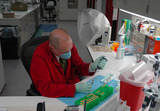
By the end of this section, you will be able to:Identify and describe the properties of lifeDescribe the levels of organization among living thingsRecognize and interpret a phylogenetic treeList examples of different sub disciplines in biology

By the end of this section, you will be able to:Identify and describe the properties of lifeDescribe the levels of organization among living thingsRecognize and interpret a phylogenetic treeList examples of different sub disciplines in biology

This learning video introduces high school students to a topic they would not ordinarily study in school, biotechnology, and to different applications of biotechnology that relate to the main theme of the module - making the desert greener. After reviewing traditional methods used for manipulating plants to produce desired traits, students will learn about the methods of making transgenic plants. Dr. Ziad discusses a real world problem that is critical in his country, Jordan, where much of the land is desert. A prerequisite to this video lesson is some background in biology.

This list of botanical gardens and arboretums includes links to Web sites which you can search for institutions in your region. In addition, it includes detailed information about 14 of the country's largest botanical gardens and arboretums. Where possible, it includes the following information for each: mailing address and phone number, Web site and email address, details about its grounds and collections, and the type of support offered, including educational materials, resource libraries, and classes/workshops.
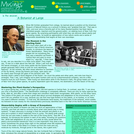
This online article, from the museum's Musings newsletter for educators, profiles two scientists who lead walking tours in New York City's green spaces. Bill Schiller, a botany lecturer and senior museum instructor, discusses the ways in which he "builds an appreciation of how nature works and a sense of responsible stewardship" during his tours. Bob DeCandido, an urban park ranger, explains how he "teaches city-dwellers to look closely at their wild neighbors and become better environmental stewards in the process." The article also includes ideas for four activities that can be completed during a walking tour.
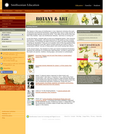
The lessons in this issue of Smithsonian in Your Classroom introduce the work of botanists and botanical illustrators, specifically their race to make records of endangered plant species around the world. “Very little of the world’s flora has been fully studied,” says one Smithsonian botanist, “and time is running out.” In the first lesson, students gets to know six endangered plants. They examine illustrations, photographs, and dried specimens of the plants as they consider this question: If a scientist can take a picture of a plant, are there advantages in having an illustration? They go on to consider some of the big questions that botanists themselves must ask: Which of these species are most in need of conservation efforts? Are any of these plants more worth saving than others?In the second lesson, the students try their own hands at botanical illustration, following the methods of a Smithsonian staff illustrator. All that is required for the lesson are pencils, markers, tracing paper, and access to a photocopier.
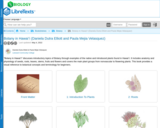
"Botany in Hawai‘i" discusses introductory topics of Botany through examples of the native and introduced plants found in Hawai‘i. It includes anatomy and physiology of seeds, roots, leaves, stems, fruits and flowers and covers the main plant groups from nonvascular to flowering plants. This book provides a visual reference to botanical concepts and terminology for beginners.
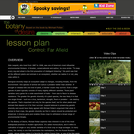
In The Botany of Desire, Michael Pollan explores risks inherent in one of the most widespread practices in modern agriculture. It's called monoculture, and it refers to cultivation of single or very similar varieties of a food crop on large acreages. In many cases, the variety is one that dominates the marketplace, like the Russet Burbank potato, whose shape makes it a favorite for cutting French fries, or one of the few apple varieties commonly seen in supermarkets. Monoculture may offer economic advantages, but Pollan argues that it brings serious environmental risks.

Diversidad vegetal y florística. Métodos de estudio de la diversidad vegetal.

This resource is a video abstract of a research paper created by Research Square on behalf of its authors. It provides a synopsis that's easy to understand, and can be used to introduce the topics it covers to students, researchers, and the general public. The video's transcript is also provided in full, with a portion provided below for preview:
"Tropical maize hybrid, a single cross of flint and dent inbred lines, is an important crop throughout the Americas and Africa. Crop yield, however, is highly dependent on nitrogen availability, and fertilizers are therefore often necessary to increase production. Developing more nitrogen-efficient maize would not only cut costs for farmers, it would also increase crop yield and reduce environmental impacts. But how do you make a plant more nitrogen efficient? The performance and production of crops can be improved by selectively crossing individuals with desired traits. When such plants are crossed, they produce hybrids that are often bigger, stronger, and more vigorous than either of the parent plants. By carefully choosing which individuals are used in creating these hybrids, specific traits, such as nitrogen efficiency, can be selected for..."
The rest of the transcript, along with a link to the research itself, is available on the resource itself.

This video will help students, particularly those not in AP-level classes, have a practical application for knowing about the major divisions between plants, particularly about the details of plant anatomy and reproduction. Students will be able to :Identify the major evolutionary innovations that separate plant divisions, and classify plants as belonging to one of those divisions based on phenotypic differences in plants. Classify plants by their pollen dispersal methods using pollen dispersal mapping, and justify the location of a _crime scene_ using map analysis. Analyze and present their analysis of banding patterns from DNA fingerprinting done using plants in a forensic context.
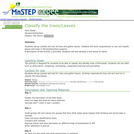
This activity is a field investigation where students gather leaves from various trees on school property, interpret findings, name tree and leaves, journal activity and develop a new "aha" for nature!
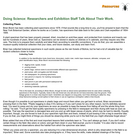
This article, part of Biodiversity Counts, takes a look at collecting plant specimens. The article discusses what tools are needed to collect specimens, how to press and dry specimens and has tips for numbering and labeling specimens.
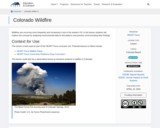
Wildfires are occurring more frequently and increasing in size in the western US; in this lesson students will explore this concept by analyzing environmental data to find patterns and practice communicating their findings.
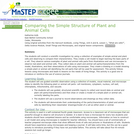
The lesson is designed for fourth grade students using scientific investigation to identify and compare the basic parts of a plant and animal cells. This activity consists of several steps over a period of several days. It includes student use of microscopes for observations and journals to collect data to identify and classify the basic parts of plant and animal cells. The assessment has an individual component and uses student work.
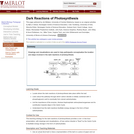
The dark reactions of photosynthesis (Calvin Cycle) are presented in this learning experience to show where these processes take place in the plant as well as the specific reactions involved.
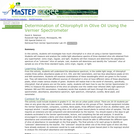
In this activity, students will investigate how much chlorophyll is in olive oil using a Varnier Spectrometer. Students will measure and analyze the visible light absorbance spectra of three standard olive oils obtained from any supermarket: extra virgin, regular, and light.
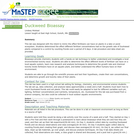
This activity is a bioassay lab where students tested the effect of an environmental toxin (fertilizer) on the growth rate of Duckweed.
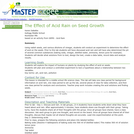
This activity is an in class lab where students will compare different acid solutions on seed germination and growth.